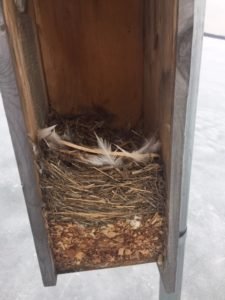A February 2019 Volunteer Newsletter article by Bruce Urben, President
Each year a WWA provides hundreds of wood duck boxes to individuals to try to put more ducks on the landscape. Duck boxes are raffled at events, given to conservation groups, and sold to our membership.
When you choose to put up a wood duck box you also commit to maintaining that box. Non-maintained wood duck boxes can be death traps for hatchlings if they cannot get out of the box or if predator guards are not in place.
January to March is the ideal time to maintain your boxes. Wetland areas are frozen over and boxes are usually accessible. I do remember several years where snowshoes were necessary due to late season snowfall, however.
Ok, so what needs to be done to maintain your boxes? First, open the box and inspect and make any needed repairs. Is the screen still intact in the inside for the chicks to grip to get out? If the box is cracked or the entrance hole has been enlarged by squirrels or raccoons, it needs to be replaced. Check for cracked egg shells, a sure sign of the box having a successful hatch. Observe the hatch success rate and record for future comparison.
Next, remove all of the existing bedding, any cracked or unhatched eggs along with any bird nests or grass from starlings.
Then, replace the bedding with dry wood shavings. Cedar shavings are the best bedding material, do not use sawdust! It is important to supply bedding because the hen wood duck is unable to bring bedding into the box herself. 3 to 4 inches of bedding is sufficient.
Now you should replace and secure the duck box door and inspect and/or replace the predator guard if necessary. Remove any close hanging branches that may be encroaching on the box, they are a sure bet to attract unwanted predators for easy access to the box from above.

A wood duck box house, checked by lead AWA volunteer Mike Alaimo, this month at Paradise Valley Wildlife Area.
Wood ducks lay 12-14 eggs and cover them with breast down prior to beginning incubation. If you find a clutch of unhatched eggs with down covering them, it usually means the hen was killed before she could incubate. She planned to return to incubate her eggs.
It is also not uncommon to find several unhatched eggs; this can be caused by an infertile egg or death of the embryo prior to incubation.
Maintenance is the most important part of the wood duck box formula to hatching healthy wood ducks.
Make it a family outing to check and maintain your boxes, it’s a great time to get the whole family involved and see nature firsthand!
Thank you for your commitment to Wisconsin Waterfowl and enjoy the fruits of your labor this fall!

